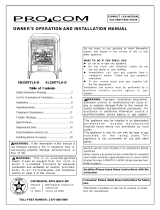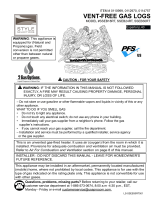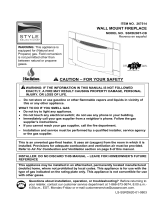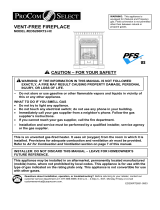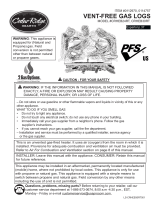
7
Figure 2 - Ventilation Air from Inside Building
Figure 3 - Ventilation Air from Outdoors
Ventilation Air From Inside Building
This fresh air would come from adjoining unconned space.
When ventilating to an adjoining unconned space, you must
provide two permanent openings: one within 12 inches of the
wall connecting the two spaces (see options 1 and 2, Figure
2). You can also remove door into adjoining room (see option
3, Figure 2). Follow the National Fuel Gas Code NFPA 54/
ANS Z223.1. Section 5.3,
Air for Combustion and Ventilation
for required size of ventilation grills or ducts.
Ventilation Air From Outdoors
Provide extra fresh air by using ventilation grills or duct. You
must provide two permanent openings: one within 12 inches
of the ceiling and one within 12 inches of the oor.
Connect these items directly to the outdoors or spaces open
to the outdoors. These spaces include attics and crawl spac-
es. Follow the National Fuel Gas Code NFPA 54/ANS Z223.1,
Section 5.3. Air for Combustion and Ventilation for required
size of ventilation grills or ducts.
IMPORTANT: Do not provide openings for inlet or outlet
air into attic if attic has a thermostat-controlled power
vent. Heated air entering the attic will activate the power
vent.
WARNING: Rework worksheet, adding the space of the
adjoining unconned space. The combined spaces must
have enough fresh air to supply all appliances in both
spaces.
PRODUCT FEATURES:
This log set has been tested and approved to ANSI Z21.11.2 standard for Unvented Heaters and can be oper-
ated with the ue damper closed. State and local codes in some areas prohibit the use of vent-free heaters.
Safety Pilot
This heater has a pilot with an Oxygen Depletion Sensing (ODS) safety
shutoff system. The ODS/pilot shuts off the heater if there is not enough
fresh air.
Piezo Ignition System
This heater is equipped with an electronic piezo ignitor. This system
requires AAA batteries (provided).
CAUTION: Do not remove the metal data plates from the grate as-
sembly. The data plates contain important product information
LOCAL CODES
lnstall and use heater with care. Follow all local codes. In the absence of
local codes, use the latest edition of The National Fuel Gas Code, ANSI
Z223.1, also known as NFPA 54*.
*Available from:
State of Massachusetts: The instal-
lation must be made by a licensed
plumber or gas tter in the Common-
wealth of Massachusetts.
Sellers of unvented propane or natural
gas-red supplemental room heaters
shall provide to each purchaser a copy
of 527 CMR 30 upon sale of the unit.
In the state of Massachusetts, unvent-
ed propane or natural gas-red space
heaters shall be prohibited in bedrooms
and bathrooms.
In the State of Massachusetts the
gas cock must be a “T” handle type.
The State of Massachusetts requires
that a exible appliance connector
cannot exceed three feet in length.
American National Standards Institute, Lnc.
1430 Broadway
New York, NY 10018
National Fire Protection Association, lnc.
1 Batterymarch Park
Quincy, MA 02269-9101




















